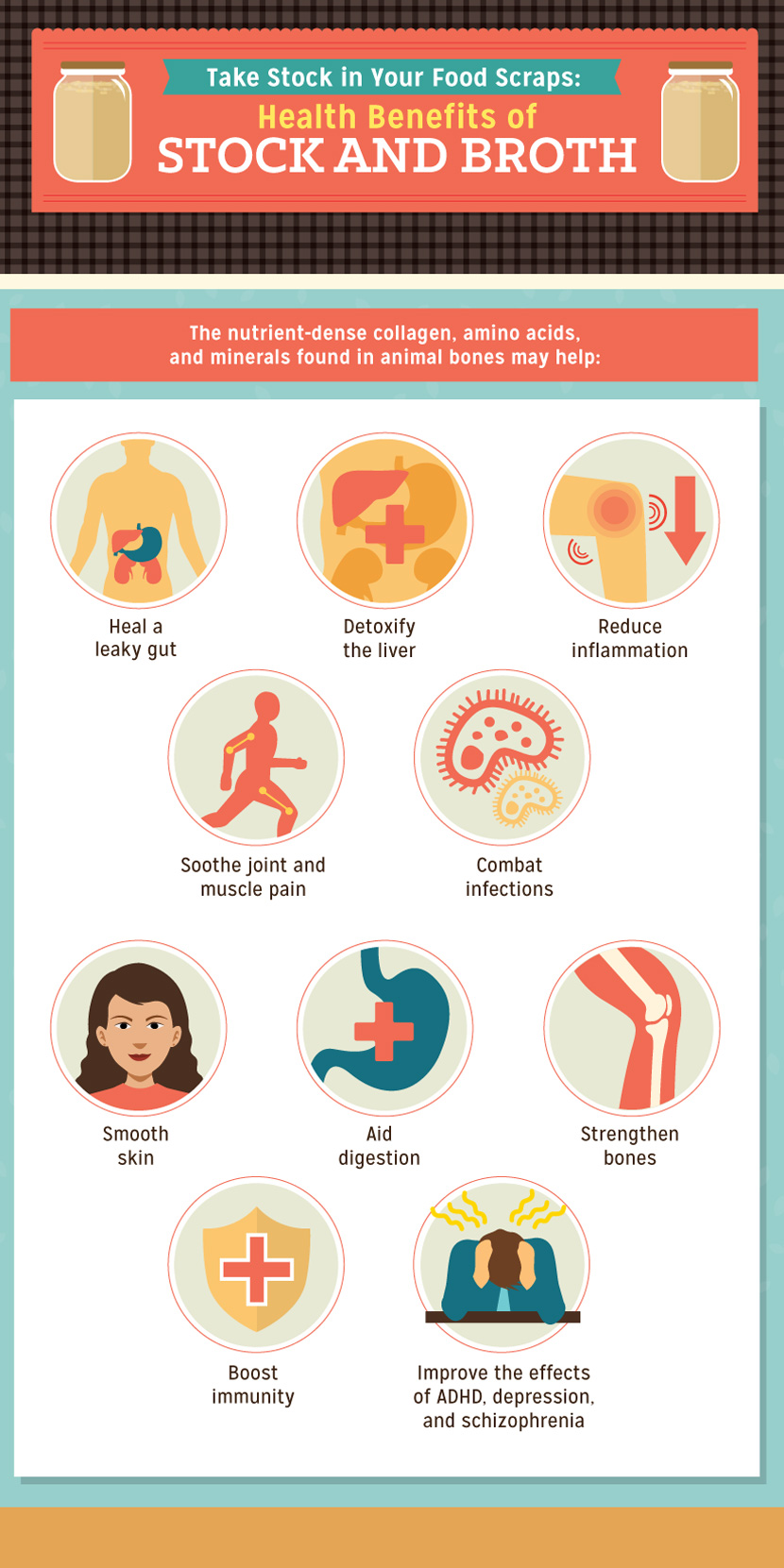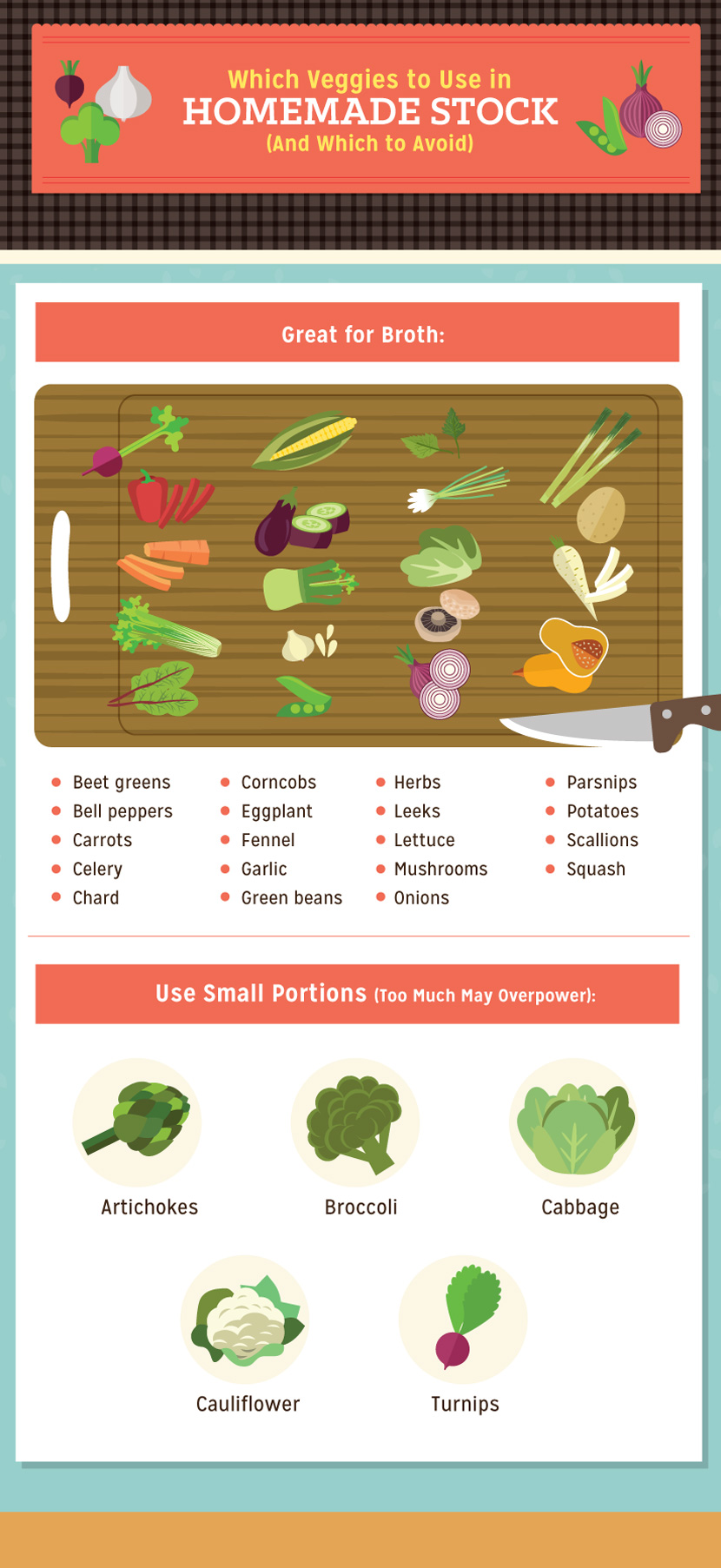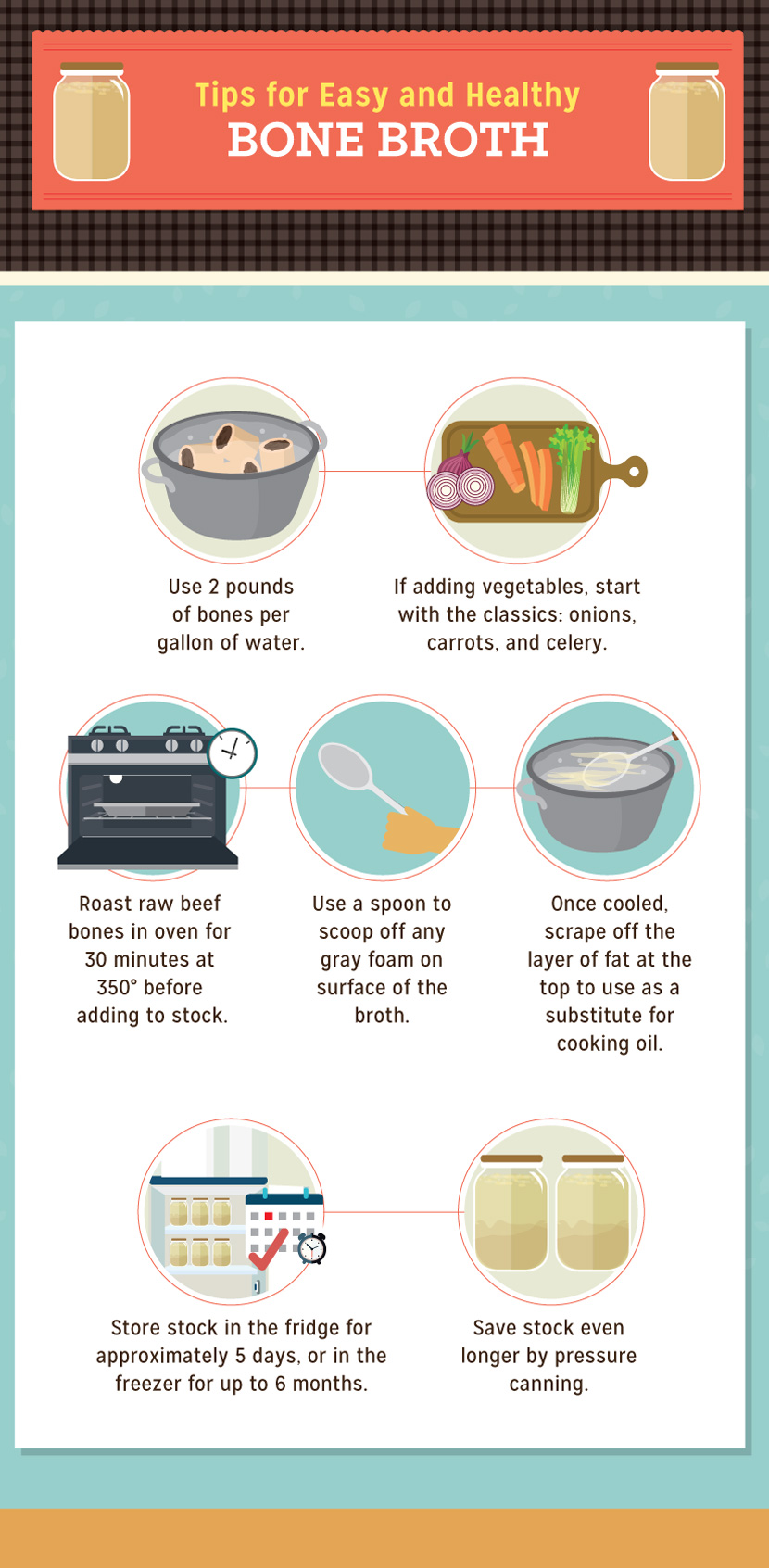Stocking Up
Make Your Very Own Bone Broth and Vegetable Broth With These Recipes
Stock has become the food trend du jour in recent years – New York City even has a dedicated broth storefront – but people have used and sipped on broth for centuries. Made from the liquid that’s left after vegetables, herbs, or bones and meat are simmered and then strained of solids, stock is used as a traditional, wholesome remedy for a wide range of ailments. It’s an incredibly versatile kitchen ingredient: any chef worth his or her salt keeps stock on hand at all times. Making stock also cuts down on food waste, thereby reducing a household’s eco-footprint.
Ready to get in on the action? Homemade broth is incredibly easy even for novice home chefs. Read on to learn what makes stock valuable and how to put it to good use.
For the purposes of this article, we’ll be using the words “stock” and “broth” interchangeably, but technically, there is a difference. With the exception of vegetable stocks, broth and stock both utilize bones and meat. Some sources say that stock has a greater ratio of bones to meat, while broth tends to have more seasoning. http://www.nytimes.com/2015/01/07/dining/bone-broth-evolves-from-prehistoric-food-to-paleo-drink.html?_r=1 http://www.thekitchn.com/whats-the-difference-between-stock-and-broth-word-of-mouth-71199
Why Stock?
Despite its presence in kitchens around the globe, there’s relatively little research about the health benefits of stock. Proponents of the seasoned liquid suggest that the nutrient-dense collagen, amino acids, and minerals found in animal bones may heal a leaky gut, detox the liver, reduce inflammation, soothe joint and muscle pain, combat infections, smooth skin, aid digestion, strengthen bones, boost immunity, and help with ADHD, depression, and schizophrenia. http://www.nytimes.com/2015/01/07/dining/bone-broth-evolves-from-prehistoric-food-to-paleo-drink.html?_r=1 http://www.integratednaturalmedicine.com/bone-broth/ While these claims warrant further research, people around the world have consumed stock for centuries based on the premise that it does a body good.
In recent years, some critics of brothing have raised concerns about the presence of lead in broth. Because farm animals can be exposed to lead via water, air, dust, soil, and food, it may accumulate in their bones. http://chriskresser.com/bone-broth-and-lead-toxicity-should-you-be-concerned/ One small study found that chicken broth may contain a concentration of lead. http://www.ncbi.nlm.nih.gov/pubmed/23375414 This doesn’t mean that people need to swear off broths entirely, but it doesn’t hurt to take this info into account when incorporating broth into your diet. Sourcing meats from pasture-raised, grass-fed, and generally healthy animals will help guarantee the safest meats.
Stock’s environmental benefits are indisputable. Stock made of meat and veggie scraps cuts down on food waste, which is responsible for the loss of 1.3 billion tons of edible food every year – more than enough to feed everyone in the world who’s going hungry. http://greatist.com/health/how-to-ways-reduce-food-waste Wasted food fills up landfills, depletes natural resources, including land and water, and creates billions of tons of greenhouse gases. http://www.fao.org/docrep/018/i3347e/i3347e.pdf By giving food scraps a second life (and composting whatever’s left over after making stock), you can make a real dent in your eco-footprint.

How to Use Stock at Home
Stocks are incredibly versatile. They can be used as the liquid base for soups, stews, gravies, sauces, and reductions (check out these soup recipes to get started). http://wellnessmama.com/5888/how-to-make-bone-broth/ Use broth to roast or sauté vegetables, poach fish, or cook risotto, or as a substitute for oil to cook eggs. People even drink bone broth straight from the cup (think of it as the new green juice).
If you can’t use it up fast enough, consider canning stock so it stays usable until you need it.
How to Make Vegetable Stock from Food Scraps
Many food scraps serve as the base for vegetable stock. Certain vegetables – including onions, carrots, celery, leeks, potatoes, scallions, fennel, garlic, chard, lettuce, green beans, squash, bell peppers, mushrooms, beet greens, herbs, parsnips, eggplant, and corncobs – add great flavor to stock. http://www.thekitchn.com/tip-save-vegetable-scraps-for-67995
You may want to steer clear of cruciferous veggies, including cabbage, broccoli, cauliflower, turnips, and artichokes, all of which can be overpowering, especially in large quantities. http://ohmyveggies.com/how-to-make-vegetable-broth-with-kitchen-scraps/ It’s a good idea to portion these out between batches or just toss them in the compost. And while it’s fine to add wilted or slightly aged veggies to stock, do not to use any with signs of rot or mold.
Since it’s unlikely that one meal will result in enough food scraps to make a batch of stock, consider keeping a sealed bag or container in the freezer and add chopped veggie peelings, stalks, leaves, ends, and other leftovers as they accumulate. Approximately four cups of scraps should yield around two quarts of stock.
When you have enough veggies, it’s time to get brothing. There are two main approaches to vegetable stock: one is laissez-faire; the other is a little more exact. http://www.thekitchn.com/how-to-make-vegetable-stock-cooking-lessons-from-the-kitchn-136725 If you saved up food scraps, then it may be difficult to meet specific quotas – in which case, laissez-faire it is. Just follow these slightly adapted instructions. http://blog.blueapron.com/vegetable-scraps-arent-kitchen-waste-theyre-soup-material/
- Roughly chop your food scraps, and then dump them in a large pot. Aim to have a bunch of carrot, celery, and onion in the mix, if possible. These are the classic staples of veggie stock.
- Sprinkle in some herbs such as parsley and thyme or ginger and lemongrass and a few bay leaves if desired, or use any combination of spices that suits your personal taste.
- Toss in a small handful of whole black peppercorns if you have them. Otherwise, sub in regular pepper.
- Add a few whole garlic cloves if desired.
- Salt generously (like you would to cook pasta).
- Pour cold water into the pot until it just covers all the scraps.
- Bring the water to a boil, and then set the stove to medium heat and simmer (uncovered) for one to two hours.
- After turning off the stove, strain the stock and set aside the solids to compost.
- Veggie stock can be used immediately, refrigerated in glass containers for up to three days, or frozen for up to three months.
Note: If you find that your stock isn’t as flavorful as you’d like it, consider roasting the vegetableshttp://www.thekitchn.com/how-to-make-vegetable-stock-cooking-lessons-from-the-kitchn-136725 for a few minutes before adding water to the pot. http://www.thekitchn.com/how-to-make-vegetable-stock-cooking-lessons-from-the-kitchn-136725

How to Make Bone Broth
According to dedicated broth makers, bone broth is the holy grail of nutrition. This classic stock can be made from beef, bison, lamb, poultry, or fish bones. http://wellnessmama.com/5888/how-to-make-bone-broth/
Most people add vegetables and seasonings to their bone broth, but some choose to stick to just bones.
Select bones from grass-fed animals and poultry or wild-caught fish for the best quality, taste, and health and environmental benefits. You can save the bones from a meal, purchase them directly from a local butcher or farmer, or buy them online. The bonier the bones, the better – beef knuckles, chicken necks, oxtails, soup bones, and even feet all make for great stocks. http://www.shape.com/healthy-eating/cooking-ideas/8-reasons-try-bone-broth
As with vegetable stock, bone broth can be made in imprecise or more exact ways. A simple route is to dump the bones into a crockpot, add vegetables and herbs, pour in water until it just barely covers everything, and then cook the mixture on low for 24 to 72 hours. http://www.shape.com/healthy-eating/cooking-ideas/8-reasons-try-bone-broth
Want to get more specific? Consider this beef broth recipe, this chicken stock recipe, or this general bone broth recipe (which includes a fish broth version). Regardless of the option you choose, keep the following tips in mind:
- In general, a good ratio to shoot for is two pounds of bones per gallon of water.
- If adding vegetables, start with the classics – onions, carrots, and celery. These add both flavor and nutrition.
- Improve the flavor of raw beef bones by roasting them in the oven for approximately 30 minutes at 350 degrees; then add them to the stock. http://wellnessmama.com/5888/how-to-make-bone-broth/
- Some bones (especially those from animals that aren’t pasture-raised) can produce gray foam that rises to the surface while the mixture simmers. Scoop this off the surface with a spoon. http://www.motherearthnews.com/real-food/seasonal-recipes/how-to-make-homemade-stock-ze0z1412zcwil.aspx
- When stock boils, proteins accumulate near the surface. These won’t hurt you, but go ahead and strain them off before adding the stock to storage containers. http://www.motherearthnews.com/real-food/seasonal-recipes/how-to-make-homemade-stock-ze0z1412zcwil.aspx
- Speaking of storage, when the broth is done simmering, strain it and pour into sanitized glass jars, leaving an inch at the top. Screw the lid on lightly (this helps prevent cracked glass as the liquid cools and expands). http://alexxstuart.com/10-reasons-to-make-your-own-stock
- As the stock cools, a solid layer of fat forms on top – this is normal, so don’t panic. Scrape off this healthy fat and substitute it for cooking oil. http://alexxstuart.com/10-reasons-to-make-your-own-stock
- Store stock in the fridge for approximately five days or in the freezer for up to six months. http://alexxstuart.com/10-reasons-to-make-your-own-stock
- If you make stock faster than you use it, pressure canning is a great way to preserve stock for future use.

Consuming stock is a great way to care for yourself and the planet. Even amateur home chefs can make a simple, delicious broth. May your freezer be stocked with your broth for years to come.
Embed the article on your site

